A Helpful guide on
Basics of Hearing Loss & Hearing Aids
In the Fast evolving technology, The Hearing Aids have also evolved which now offer many Advaced and Smart features. This is a basic guideline on Hearing Loss & Hearing Aids for you to decide that what type of Hearing Aid fulfils your need.
All our senses are a blessing. Value them
Hearing Loss Doesn't only affect you, But also the People around you.
Hearing loss can have a huge impact on your personal and professional life, from your work life to your relationships and emotional well-being of You and People around you. Your Hearing loss not just only affects your life, but it also has a huge effect on the people around you, who love you and are around you to take care of you. Hearing aids can make a big difference, especially if you pick the right ones and get help adjusting to them.
Hearing loss that’s due to problems with the ear canal, eardrum, or middle ear is called conductive hearing loss. Most of the time, surgery or other medical help can make it better. But those options aren’t right for everyone. If you have an open ear canal and a relatively normal external ear, a hearing aid may help.
Not everyone with hearing loss can benefit from hearing aids. But only 1 in 5 people who could have improvement wear them. Most of the time, they’re for people who have damage to their inner ear or the nerve that links the ear with the brain. The damage can come from:
- Disease
- Aging
- Loud noises
- Medications
How Hearing Aids Work.

A hearing aid is a battery-powered electronic device designed to improve your hearing. Small enough to wear in or behind your ear, they make some sounds louder. They may help you hear better when it’s quiet and when it’s noisy. Here’s how they work:
- A microphone picks up sound around you.
- An amplifier makes the sound louder.
- A receiver sends these amplified sounds into your ear.
All hearing aids use the same basic parts to carry sounds from the environment into your ear and make them louder. Most hearing aids are digital, and all are powered with a traditional hearing aid battery or a rechargeable battery.
Small microphones collect sounds from the environment. A computer chip with an amplifier converts the incoming sound into digital code. It analyzes and adjusts the sound based on your hearing loss, listening needs and the level of the sounds around you. The amplified signals are then converted back into sound waves and delivered to your ears through speakers, sometimes called receivers.
Types and Styles of Hearing Aids
Book an appointment with us to figure out which kind of hearing aid will work best for you, as well as any special features you need. The right device for you depends on:
- The type of hearing loss you have and how severe it is
- Your age
- How well you can manage small devices
- Your lifestyle
Cost. The devices vary greatly in price, from Thousands to Hundred Thousands of Rupees.
There are two main types of hearing aids:
Analog hearing aids convert sound waves into electrical signals and then make them louder. They’re usually less expensive and have simple volume controls. Digital hearing aids convert sound waves into numerical codes similar to computer codes, then amplify them. The code includes information about the direction of a sound and its pitch or volume. That makes it easier to adjust the sound to what you need, whether you’re in a restaurant, a quiet room, or a stadium. Most will adjust automatically. Although this type costs more than an analog hearing aid, the results are much better. They’re also smaller and more powerful.
There are Four main styles of hearing aids.
- Canal including ITC (In The Canal) & CIC (Completely in Canal -In The Ear (ITE) - Behind The Ear (BTE) - Reciever in Canal (RIC) All of these are discussed in detail further.


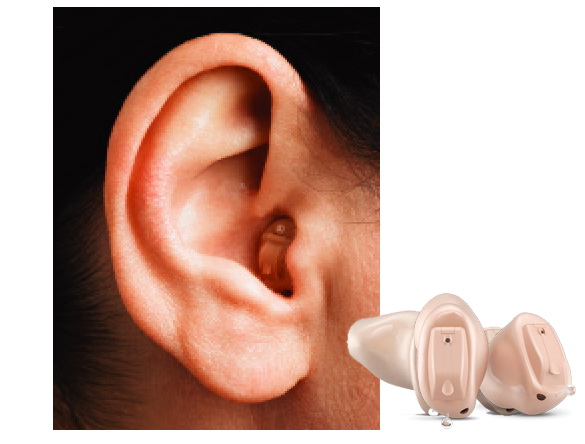
Completely In Canal (CIC)
A completely-in-canal (CIC) aid is smaller and nearly hidden in your ear. Either type can help mild to moderately severe hearing loss. But because of their size, they can be harder to adjust and remove. This style of hearing aid isn’t ideal for children or adults who might have problems with very small devices. An invisible-in-canal (IIC) aid is nearly impossible for others to see. You may put it in every day, or it may be a device you wear for several months at a time.
- Is the smallest and least visible type
- Is less likely to pick up wind noise
- Uses very small batteries, which have shorter life and can be difficult to handle
- Often doesn’t include extra features, such as volume control or a directional microphone
- Is susceptible to earwax clogging the speaker
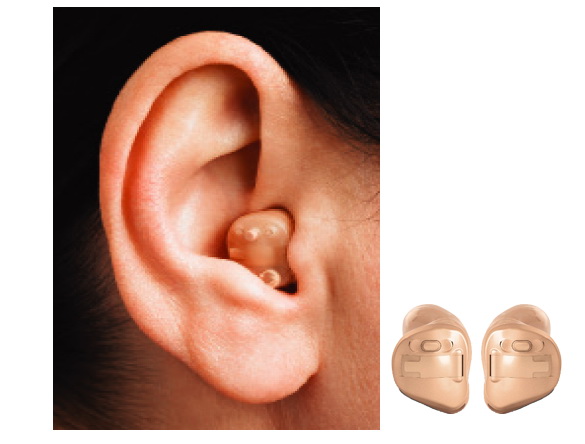
In The Canal (ITC)
In The Canal (ITC) hearing aids are slightly larger, and extend a little farther out than CIC hearing aids. However, due to their slightly larger size, ITC hearing aids can accommodate more features than CICs. Like CICs, these hearing aids are also custom fit for your ears.
- Is less visible in the ear than larger styles
- Includes features that won’t fit on completely-in-the-canal aids, but may be difficult to adjust due to its small size
- Is susceptible to earwax clogging the speaker
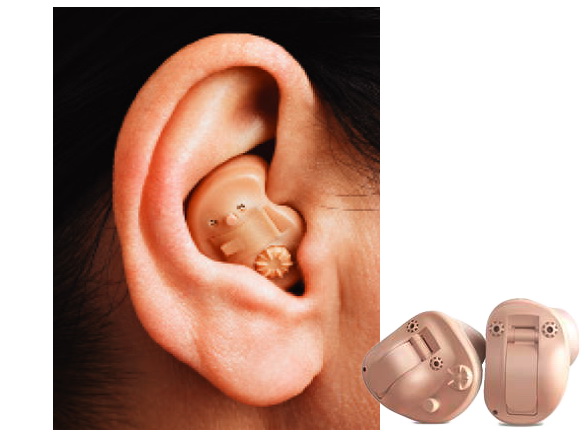
In The Ear (ITE)
In-the-ear (ITE) hearing aids fit completely inside your outer ear. They have a hard plastic case that holds the electronics. They’re best for people with mild to severe hearing loss, but they don’t work as well for children whose ears are still growing.
- Includes features that don’t fit on smaller style hearing aids, such as a volume control
- May be easier to handle
- Uses a larger battery for longer battery life, with several options for rechargeable batteries
- Is susceptible to earwax clogging the speaker
- May pick up more wind noise than do smaller devices
- Is more visible in the ear than smaller devices
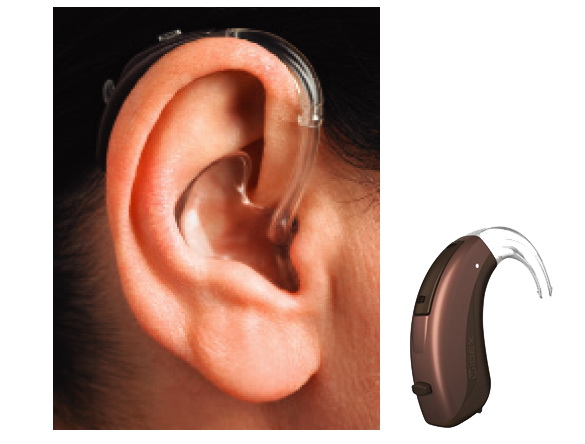
Behind The Ear (BTE)
Behind-the-ear (BTE) hearing aids sit in a hard plastic case behind your ear. A plastic ear mold fits inside the outer ear and directs sound to the ear. A different type, called a Mini BTE, fits entirely behind your ear, with a narrow tube that goes into your ear canal. This helps keep earwax from building up and makes sure your own voice sounds clear. BTEs can work for mild to severe hearing loss, but they aren’t for everyone.
- Traditionally has been the largest type of hearing aid, though some newer mini designs are streamlined and barely visible
- Has directional microphones
- Is capable of more amplification than are other styles
- May pick up more wind noise than do other styles
- May be available with a rechargeable battery
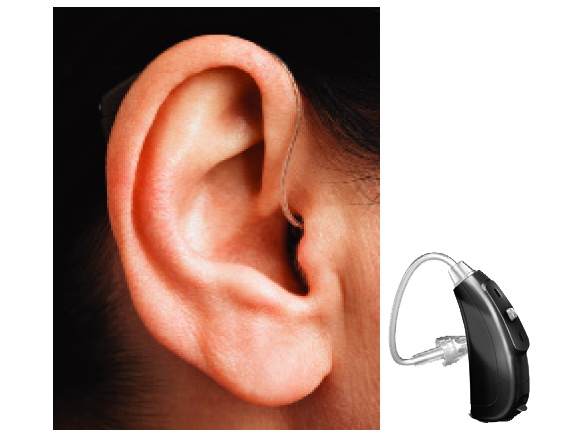
Receiver In Canal (RIC)
Receiver-in-canal (RIC) and receiver-in-the-ear (RITE) styles both have a behind-the-ear component that connects to a receiver in the ear or ear canal with a tiny wire. These allow low-frequency sounds to enter the ear naturally and high-frequency sounds to be amplified through the hearing aid. RIC and RITE may be a good choice for people with mild to profound hearing loss.
- Typically has a less visible behind-the-ear portion
- Has directional microphones
- Has manual control options
- May be available with rechargeable battery
- Is susceptible to earwax clogging the speaker
At Central Optical & Hearing care Centre, we offer the most comprehensive diagnostic facilities and the latest technology in hearing aids to suit your needs and lifestyle. For any further information regarding hearing aid features or function please visit us or call us at +92(300)9200222
Adjusting to Hearing Aids
It’s important to understand that your hearing aid can’t make your hearing what it used to be. But as you use it, you’ll become more aware of sounds and where they are coming from.
When you first get your hearing aids, be patient. It may take some time to get used to them.
Take time to learn how your hearing aids work and insist on a good fit. We Work closely with you to avoid problems such as:
- Discomfort
- Echo-like sounds from your voice
- Feedback or a whistling sound
- Background noise
- Buzzing with cell phone use
Getting used to a hearing aid takes time. You’ll likely notice that your listening skills improve gradually as you become accustomed to amplification. Even your own voice sounds different when you wear a hearing aid.
When first using a hearing aid, keep these points in mind:
- Hearing aids won’t return your hearing to normal.Hearing aids can’t restore normal hearing. They can improve your hearing by amplifying soft sounds.
- Allow time to get used to the hearing aid.It takes time to get used to your new hearing aid. But the more you use it, the more quickly you’ll adjust to amplified sounds.
- Practice using the hearing aid in different environments.Your amplified hearing will sound different in different places.
- Seek support and try to stay positive.A willingness to practice and the support of family and friends help determine your success with your new hearing aid. You may also consider discussing with people who have hearing loss or are experienced hearing aid users.
- Come back for a follow-up. You are always welcome at Central Optical & Hearing Care Centre to discuss any issues you face with your new hearing aid. Minor adjustments in Programming and Settings can be done on the spot to rectify any issues that you face, plus, we don’t charge any follow up fee up to six months.
We offer the most comprehensive diagnostic facilities and the latest technology in hearing aids to suit your needs and lifestyle. Our Diagnostic Clinic is managed under Specialist Doctor. If hearing is a problem for you, get in touch with us today – We are listening! Call us on +92 (300)9200222!

























